Developing Performance: Recommending Reward System at Cavendish Hotel
VerifiedAdded on 2023/06/11
|11
|3071
|441
Report
AI Summary
This report assesses the individual performance-related pay system at Cavendish Hall Hotel, a four-star establishment with five departments, which has been in place for three years. The hotel manager, Daphne, seeks to evaluate the effectiveness of this system due to complaints of ineffective and unfriendly employees and poor service. The report draws on various studies indicating the ineffectiveness of individual performance-related pay, despite its potential advantages. It recommends alternative reward approaches, such as team-based pay, where employees are rewarded collectively for achieving organizational goals, and basic pay, which provides a regular salary without incentives. The report suggests that these alternatives may address the issues arising from the current system and improve overall employee motivation and organizational productivity. Desklib provides access to similar solved assignments and study resources for students.
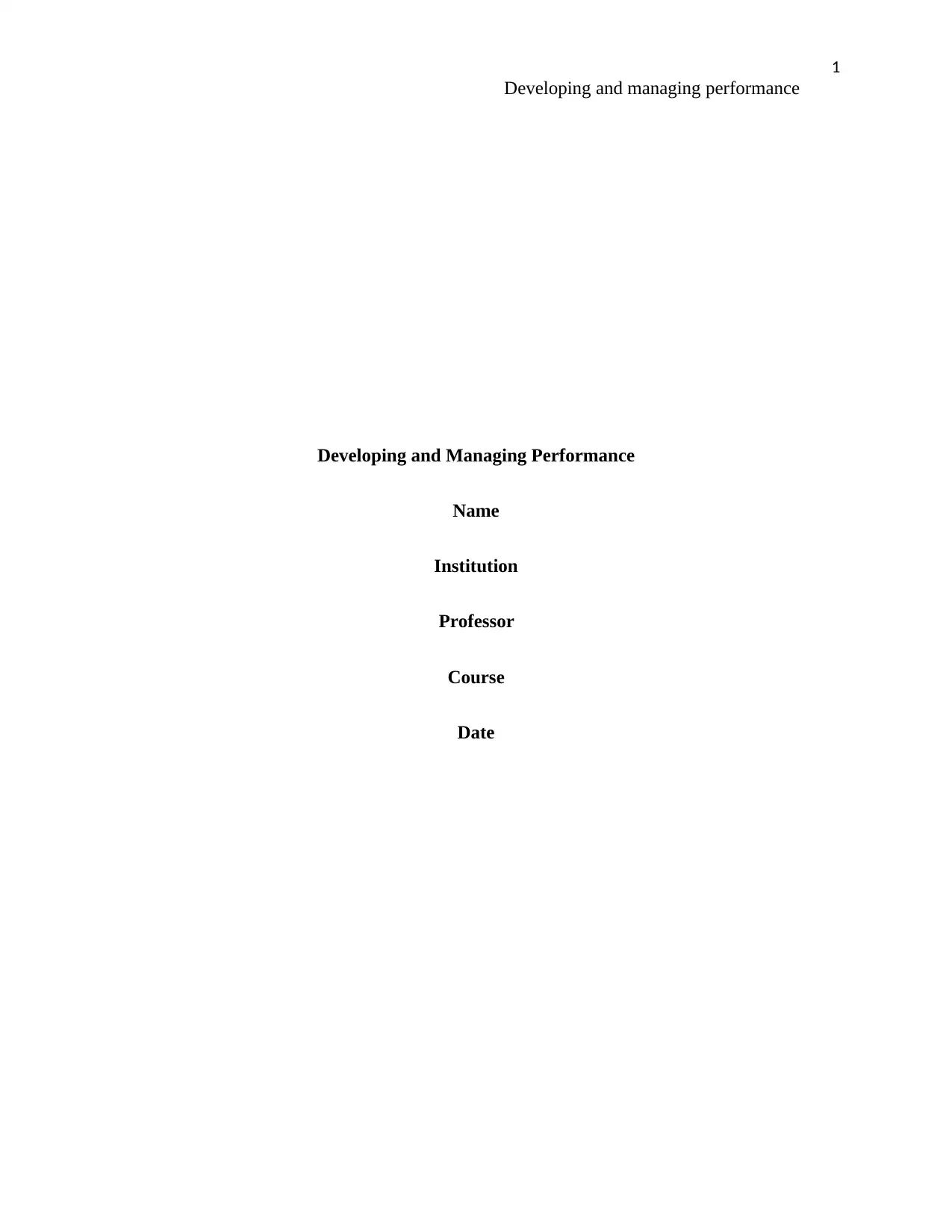
1
Developing and managing performance
Developing and Managing Performance
Name
Institution
Professor
Course
Date
Developing and managing performance
Developing and Managing Performance
Name
Institution
Professor
Course
Date
Paraphrase This Document
Need a fresh take? Get an instant paraphrase of this document with our AI Paraphraser
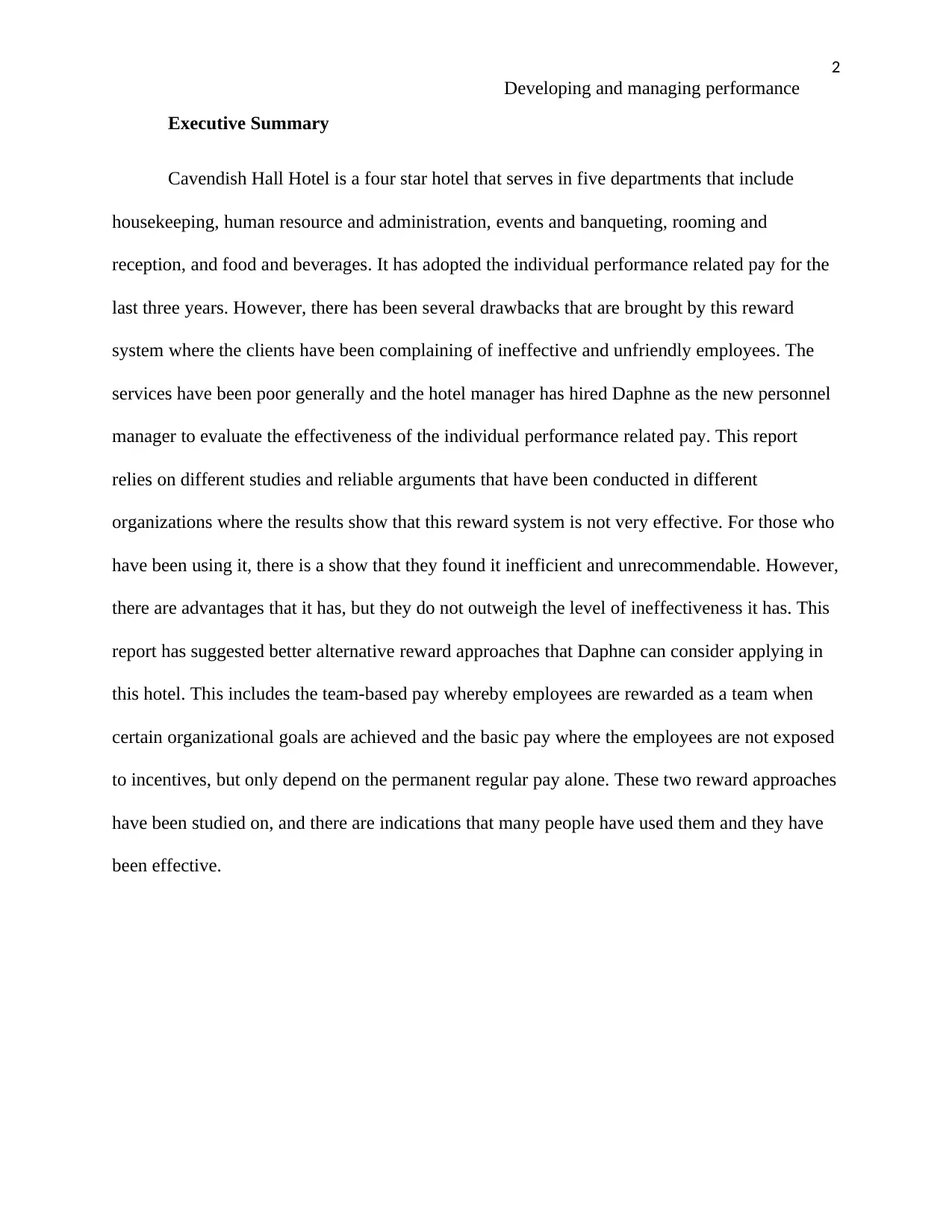
2
Developing and managing performance
Executive Summary
Cavendish Hall Hotel is a four star hotel that serves in five departments that include
housekeeping, human resource and administration, events and banqueting, rooming and
reception, and food and beverages. It has adopted the individual performance related pay for the
last three years. However, there has been several drawbacks that are brought by this reward
system where the clients have been complaining of ineffective and unfriendly employees. The
services have been poor generally and the hotel manager has hired Daphne as the new personnel
manager to evaluate the effectiveness of the individual performance related pay. This report
relies on different studies and reliable arguments that have been conducted in different
organizations where the results show that this reward system is not very effective. For those who
have been using it, there is a show that they found it inefficient and unrecommendable. However,
there are advantages that it has, but they do not outweigh the level of ineffectiveness it has. This
report has suggested better alternative reward approaches that Daphne can consider applying in
this hotel. This includes the team-based pay whereby employees are rewarded as a team when
certain organizational goals are achieved and the basic pay where the employees are not exposed
to incentives, but only depend on the permanent regular pay alone. These two reward approaches
have been studied on, and there are indications that many people have used them and they have
been effective.
Developing and managing performance
Executive Summary
Cavendish Hall Hotel is a four star hotel that serves in five departments that include
housekeeping, human resource and administration, events and banqueting, rooming and
reception, and food and beverages. It has adopted the individual performance related pay for the
last three years. However, there has been several drawbacks that are brought by this reward
system where the clients have been complaining of ineffective and unfriendly employees. The
services have been poor generally and the hotel manager has hired Daphne as the new personnel
manager to evaluate the effectiveness of the individual performance related pay. This report
relies on different studies and reliable arguments that have been conducted in different
organizations where the results show that this reward system is not very effective. For those who
have been using it, there is a show that they found it inefficient and unrecommendable. However,
there are advantages that it has, but they do not outweigh the level of ineffectiveness it has. This
report has suggested better alternative reward approaches that Daphne can consider applying in
this hotel. This includes the team-based pay whereby employees are rewarded as a team when
certain organizational goals are achieved and the basic pay where the employees are not exposed
to incentives, but only depend on the permanent regular pay alone. These two reward approaches
have been studied on, and there are indications that many people have used them and they have
been effective.
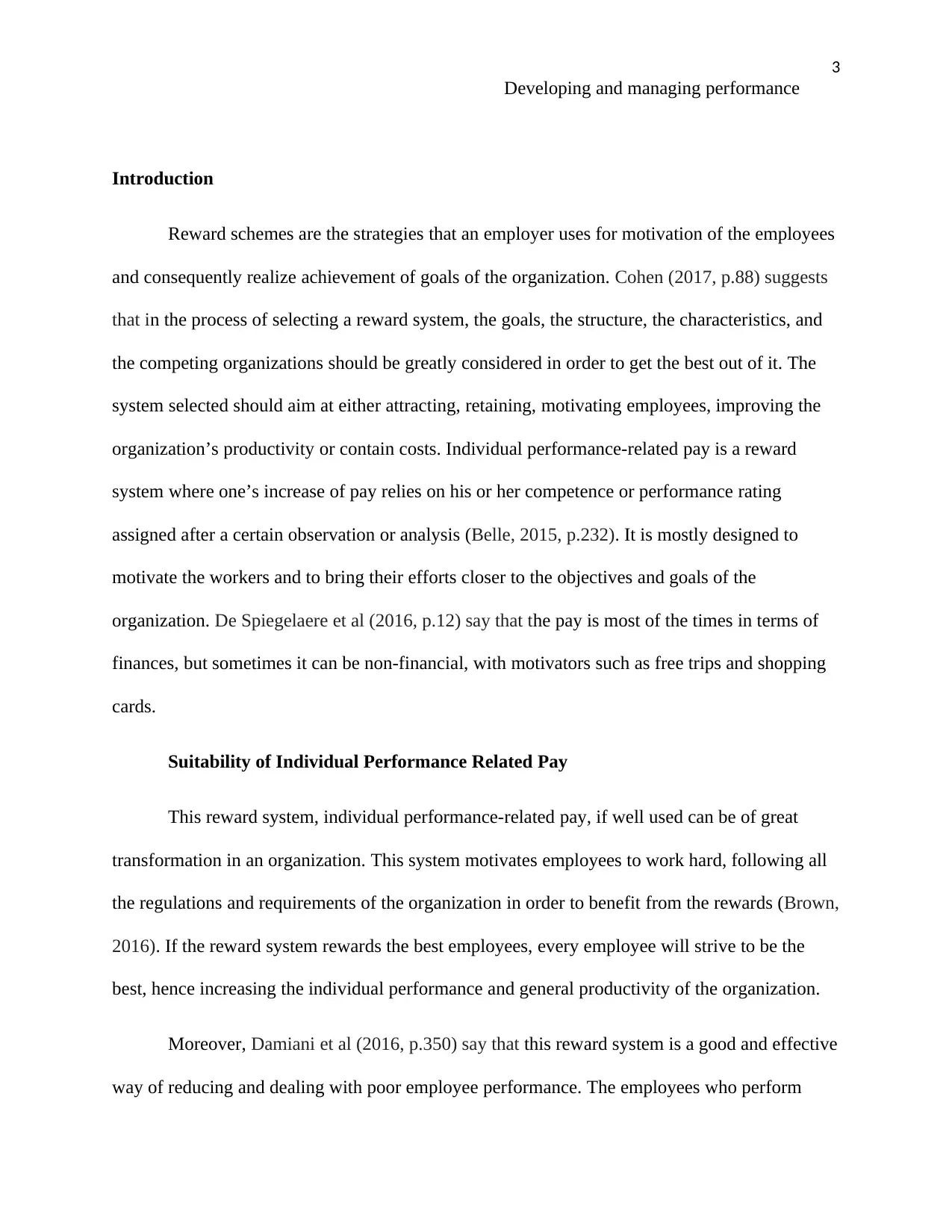
3
Developing and managing performance
Introduction
Reward schemes are the strategies that an employer uses for motivation of the employees
and consequently realize achievement of goals of the organization. Cohen (2017, p.88) suggests
that in the process of selecting a reward system, the goals, the structure, the characteristics, and
the competing organizations should be greatly considered in order to get the best out of it. The
system selected should aim at either attracting, retaining, motivating employees, improving the
organization’s productivity or contain costs. Individual performance-related pay is a reward
system where one’s increase of pay relies on his or her competence or performance rating
assigned after a certain observation or analysis (Belle, 2015, p.232). It is mostly designed to
motivate the workers and to bring their efforts closer to the objectives and goals of the
organization. De Spiegelaere et al (2016, p.12) say that the pay is most of the times in terms of
finances, but sometimes it can be non-financial, with motivators such as free trips and shopping
cards.
Suitability of Individual Performance Related Pay
This reward system, individual performance-related pay, if well used can be of great
transformation in an organization. This system motivates employees to work hard, following all
the regulations and requirements of the organization in order to benefit from the rewards (Brown,
2016). If the reward system rewards the best employees, every employee will strive to be the
best, hence increasing the individual performance and general productivity of the organization.
Moreover, Damiani et al (2016, p.350) say that this reward system is a good and effective
way of reducing and dealing with poor employee performance. The employees who perform
Developing and managing performance
Introduction
Reward schemes are the strategies that an employer uses for motivation of the employees
and consequently realize achievement of goals of the organization. Cohen (2017, p.88) suggests
that in the process of selecting a reward system, the goals, the structure, the characteristics, and
the competing organizations should be greatly considered in order to get the best out of it. The
system selected should aim at either attracting, retaining, motivating employees, improving the
organization’s productivity or contain costs. Individual performance-related pay is a reward
system where one’s increase of pay relies on his or her competence or performance rating
assigned after a certain observation or analysis (Belle, 2015, p.232). It is mostly designed to
motivate the workers and to bring their efforts closer to the objectives and goals of the
organization. De Spiegelaere et al (2016, p.12) say that the pay is most of the times in terms of
finances, but sometimes it can be non-financial, with motivators such as free trips and shopping
cards.
Suitability of Individual Performance Related Pay
This reward system, individual performance-related pay, if well used can be of great
transformation in an organization. This system motivates employees to work hard, following all
the regulations and requirements of the organization in order to benefit from the rewards (Brown,
2016). If the reward system rewards the best employees, every employee will strive to be the
best, hence increasing the individual performance and general productivity of the organization.
Moreover, Damiani et al (2016, p.350) say that this reward system is a good and effective
way of reducing and dealing with poor employee performance. The employees who perform
⊘ This is a preview!⊘
Do you want full access?
Subscribe today to unlock all pages.

Trusted by 1+ million students worldwide
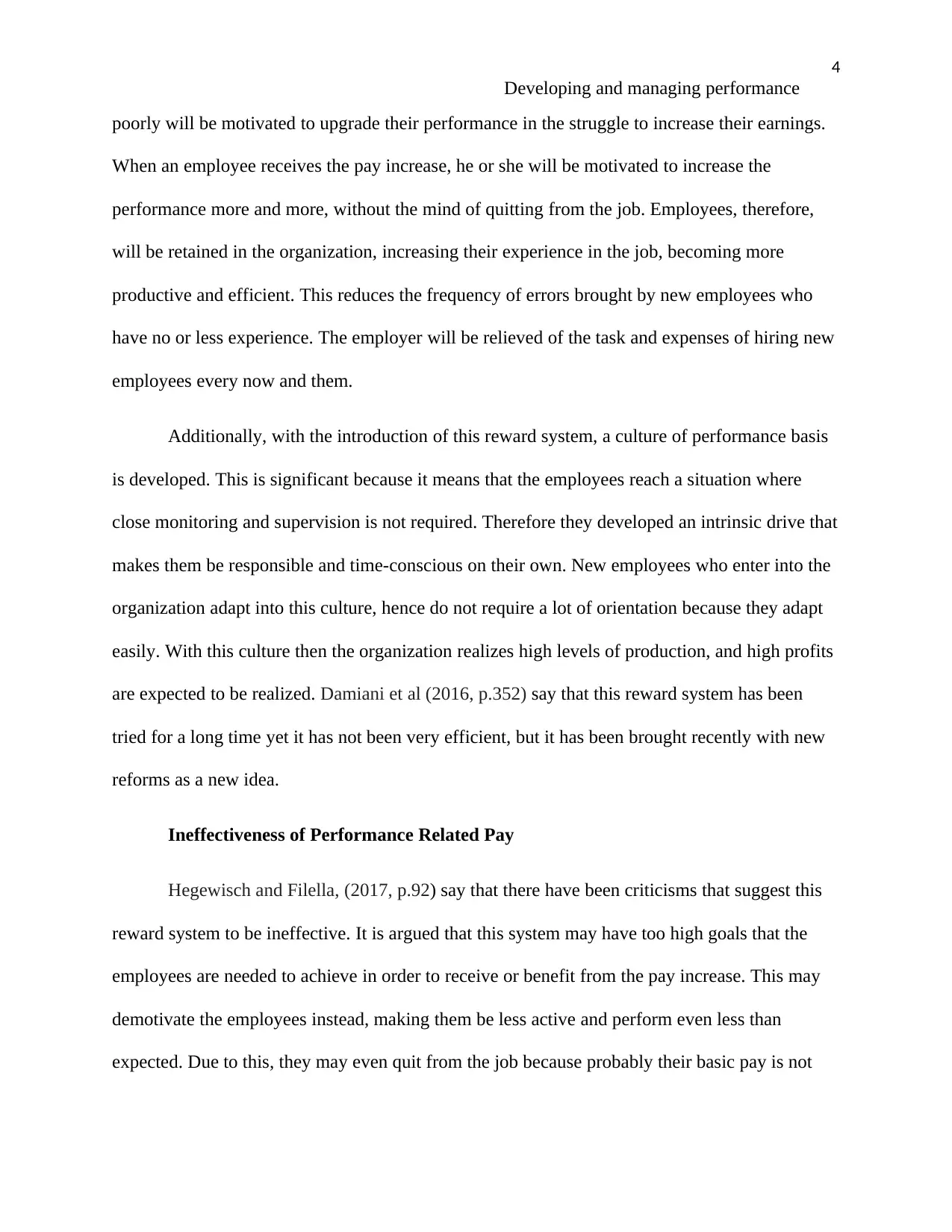
4
Developing and managing performance
poorly will be motivated to upgrade their performance in the struggle to increase their earnings.
When an employee receives the pay increase, he or she will be motivated to increase the
performance more and more, without the mind of quitting from the job. Employees, therefore,
will be retained in the organization, increasing their experience in the job, becoming more
productive and efficient. This reduces the frequency of errors brought by new employees who
have no or less experience. The employer will be relieved of the task and expenses of hiring new
employees every now and them.
Additionally, with the introduction of this reward system, a culture of performance basis
is developed. This is significant because it means that the employees reach a situation where
close monitoring and supervision is not required. Therefore they developed an intrinsic drive that
makes them be responsible and time-conscious on their own. New employees who enter into the
organization adapt into this culture, hence do not require a lot of orientation because they adapt
easily. With this culture then the organization realizes high levels of production, and high profits
are expected to be realized. Damiani et al (2016, p.352) say that this reward system has been
tried for a long time yet it has not been very efficient, but it has been brought recently with new
reforms as a new idea.
Ineffectiveness of Performance Related Pay
Hegewisch and Filella, (2017, p.92) say that there have been criticisms that suggest this
reward system to be ineffective. It is argued that this system may have too high goals that the
employees are needed to achieve in order to receive or benefit from the pay increase. This may
demotivate the employees instead, making them be less active and perform even less than
expected. Due to this, they may even quit from the job because probably their basic pay is not
Developing and managing performance
poorly will be motivated to upgrade their performance in the struggle to increase their earnings.
When an employee receives the pay increase, he or she will be motivated to increase the
performance more and more, without the mind of quitting from the job. Employees, therefore,
will be retained in the organization, increasing their experience in the job, becoming more
productive and efficient. This reduces the frequency of errors brought by new employees who
have no or less experience. The employer will be relieved of the task and expenses of hiring new
employees every now and them.
Additionally, with the introduction of this reward system, a culture of performance basis
is developed. This is significant because it means that the employees reach a situation where
close monitoring and supervision is not required. Therefore they developed an intrinsic drive that
makes them be responsible and time-conscious on their own. New employees who enter into the
organization adapt into this culture, hence do not require a lot of orientation because they adapt
easily. With this culture then the organization realizes high levels of production, and high profits
are expected to be realized. Damiani et al (2016, p.352) say that this reward system has been
tried for a long time yet it has not been very efficient, but it has been brought recently with new
reforms as a new idea.
Ineffectiveness of Performance Related Pay
Hegewisch and Filella, (2017, p.92) say that there have been criticisms that suggest this
reward system to be ineffective. It is argued that this system may have too high goals that the
employees are needed to achieve in order to receive or benefit from the pay increase. This may
demotivate the employees instead, making them be less active and perform even less than
expected. Due to this, they may even quit from the job because probably their basic pay is not
Paraphrase This Document
Need a fresh take? Get an instant paraphrase of this document with our AI Paraphraser
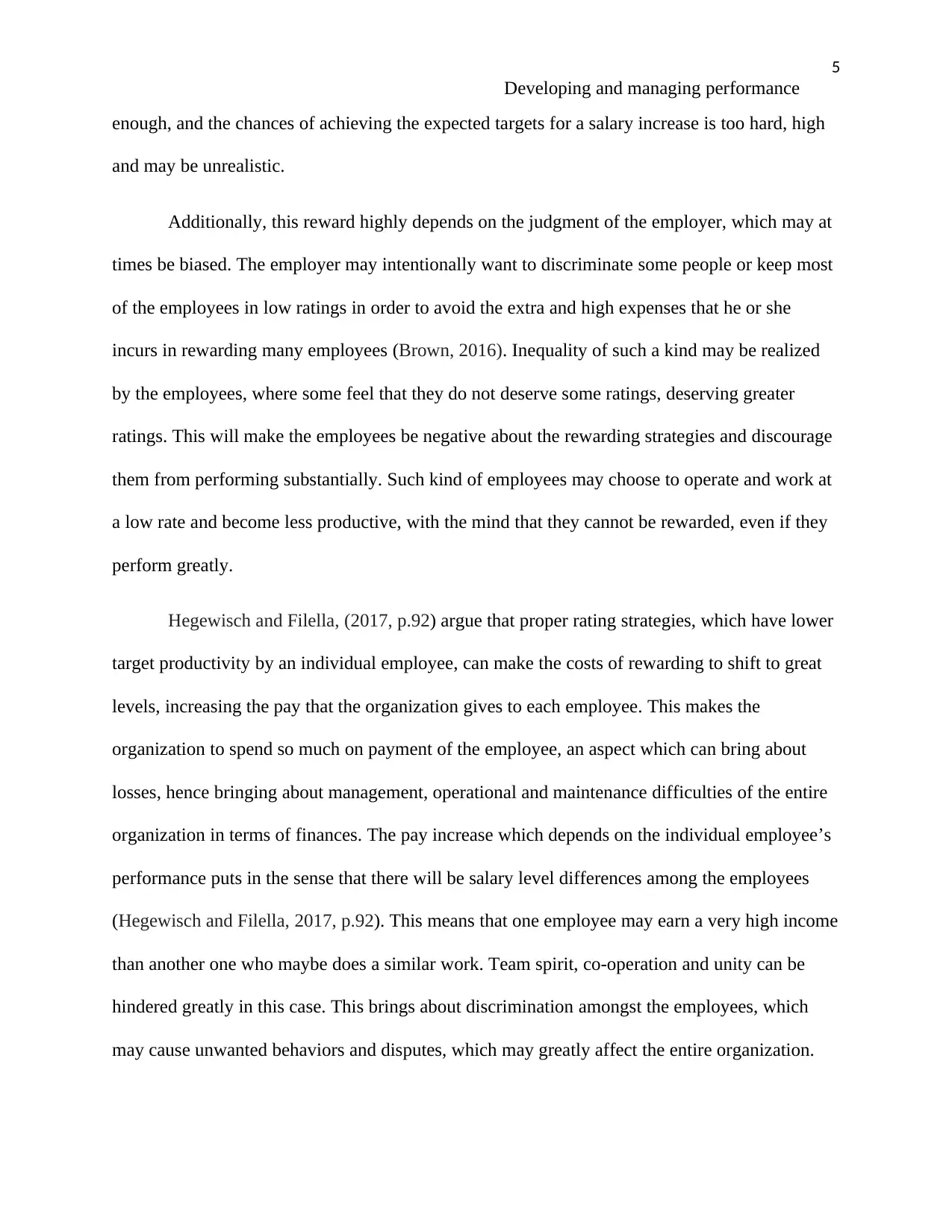
5
Developing and managing performance
enough, and the chances of achieving the expected targets for a salary increase is too hard, high
and may be unrealistic.
Additionally, this reward highly depends on the judgment of the employer, which may at
times be biased. The employer may intentionally want to discriminate some people or keep most
of the employees in low ratings in order to avoid the extra and high expenses that he or she
incurs in rewarding many employees (Brown, 2016). Inequality of such a kind may be realized
by the employees, where some feel that they do not deserve some ratings, deserving greater
ratings. This will make the employees be negative about the rewarding strategies and discourage
them from performing substantially. Such kind of employees may choose to operate and work at
a low rate and become less productive, with the mind that they cannot be rewarded, even if they
perform greatly.
Hegewisch and Filella, (2017, p.92) argue that proper rating strategies, which have lower
target productivity by an individual employee, can make the costs of rewarding to shift to great
levels, increasing the pay that the organization gives to each employee. This makes the
organization to spend so much on payment of the employee, an aspect which can bring about
losses, hence bringing about management, operational and maintenance difficulties of the entire
organization in terms of finances. The pay increase which depends on the individual employee’s
performance puts in the sense that there will be salary level differences among the employees
(Hegewisch and Filella, 2017, p.92). This means that one employee may earn a very high income
than another one who maybe does a similar work. Team spirit, co-operation and unity can be
hindered greatly in this case. This brings about discrimination amongst the employees, which
may cause unwanted behaviors and disputes, which may greatly affect the entire organization.
Developing and managing performance
enough, and the chances of achieving the expected targets for a salary increase is too hard, high
and may be unrealistic.
Additionally, this reward highly depends on the judgment of the employer, which may at
times be biased. The employer may intentionally want to discriminate some people or keep most
of the employees in low ratings in order to avoid the extra and high expenses that he or she
incurs in rewarding many employees (Brown, 2016). Inequality of such a kind may be realized
by the employees, where some feel that they do not deserve some ratings, deserving greater
ratings. This will make the employees be negative about the rewarding strategies and discourage
them from performing substantially. Such kind of employees may choose to operate and work at
a low rate and become less productive, with the mind that they cannot be rewarded, even if they
perform greatly.
Hegewisch and Filella, (2017, p.92) argue that proper rating strategies, which have lower
target productivity by an individual employee, can make the costs of rewarding to shift to great
levels, increasing the pay that the organization gives to each employee. This makes the
organization to spend so much on payment of the employee, an aspect which can bring about
losses, hence bringing about management, operational and maintenance difficulties of the entire
organization in terms of finances. The pay increase which depends on the individual employee’s
performance puts in the sense that there will be salary level differences among the employees
(Hegewisch and Filella, 2017, p.92). This means that one employee may earn a very high income
than another one who maybe does a similar work. Team spirit, co-operation and unity can be
hindered greatly in this case. This brings about discrimination amongst the employees, which
may cause unwanted behaviors and disputes, which may greatly affect the entire organization.
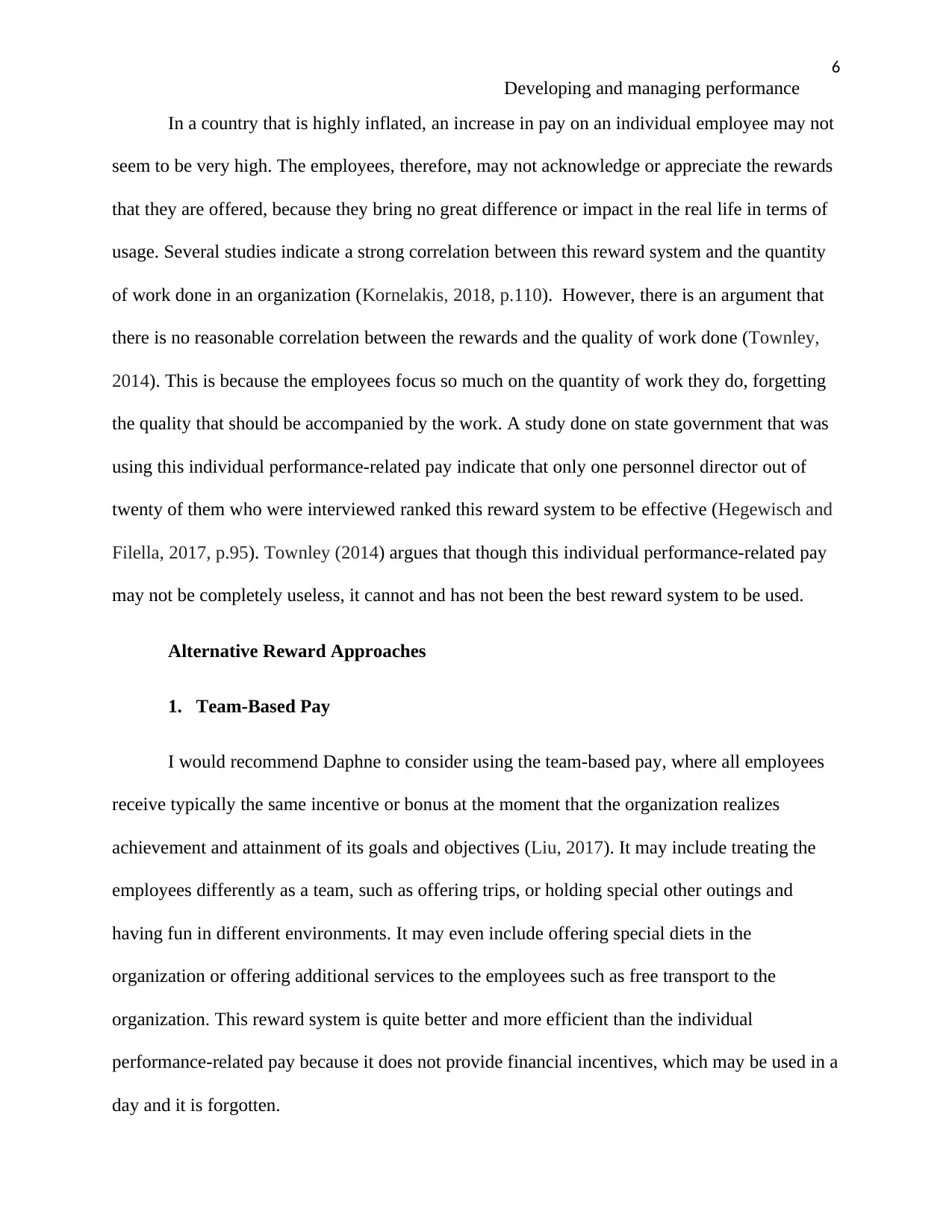
6
Developing and managing performance
In a country that is highly inflated, an increase in pay on an individual employee may not
seem to be very high. The employees, therefore, may not acknowledge or appreciate the rewards
that they are offered, because they bring no great difference or impact in the real life in terms of
usage. Several studies indicate a strong correlation between this reward system and the quantity
of work done in an organization (Kornelakis, 2018, p.110). However, there is an argument that
there is no reasonable correlation between the rewards and the quality of work done (Townley,
2014). This is because the employees focus so much on the quantity of work they do, forgetting
the quality that should be accompanied by the work. A study done on state government that was
using this individual performance-related pay indicate that only one personnel director out of
twenty of them who were interviewed ranked this reward system to be effective (Hegewisch and
Filella, 2017, p.95). Townley (2014) argues that though this individual performance-related pay
may not be completely useless, it cannot and has not been the best reward system to be used.
Alternative Reward Approaches
1. Team-Based Pay
I would recommend Daphne to consider using the team-based pay, where all employees
receive typically the same incentive or bonus at the moment that the organization realizes
achievement and attainment of its goals and objectives (Liu, 2017). It may include treating the
employees differently as a team, such as offering trips, or holding special other outings and
having fun in different environments. It may even include offering special diets in the
organization or offering additional services to the employees such as free transport to the
organization. This reward system is quite better and more efficient than the individual
performance-related pay because it does not provide financial incentives, which may be used in a
day and it is forgotten.
Developing and managing performance
In a country that is highly inflated, an increase in pay on an individual employee may not
seem to be very high. The employees, therefore, may not acknowledge or appreciate the rewards
that they are offered, because they bring no great difference or impact in the real life in terms of
usage. Several studies indicate a strong correlation between this reward system and the quantity
of work done in an organization (Kornelakis, 2018, p.110). However, there is an argument that
there is no reasonable correlation between the rewards and the quality of work done (Townley,
2014). This is because the employees focus so much on the quantity of work they do, forgetting
the quality that should be accompanied by the work. A study done on state government that was
using this individual performance-related pay indicate that only one personnel director out of
twenty of them who were interviewed ranked this reward system to be effective (Hegewisch and
Filella, 2017, p.95). Townley (2014) argues that though this individual performance-related pay
may not be completely useless, it cannot and has not been the best reward system to be used.
Alternative Reward Approaches
1. Team-Based Pay
I would recommend Daphne to consider using the team-based pay, where all employees
receive typically the same incentive or bonus at the moment that the organization realizes
achievement and attainment of its goals and objectives (Liu, 2017). It may include treating the
employees differently as a team, such as offering trips, or holding special other outings and
having fun in different environments. It may even include offering special diets in the
organization or offering additional services to the employees such as free transport to the
organization. This reward system is quite better and more efficient than the individual
performance-related pay because it does not provide financial incentives, which may be used in a
day and it is forgotten.
⊘ This is a preview!⊘
Do you want full access?
Subscribe today to unlock all pages.

Trusted by 1+ million students worldwide
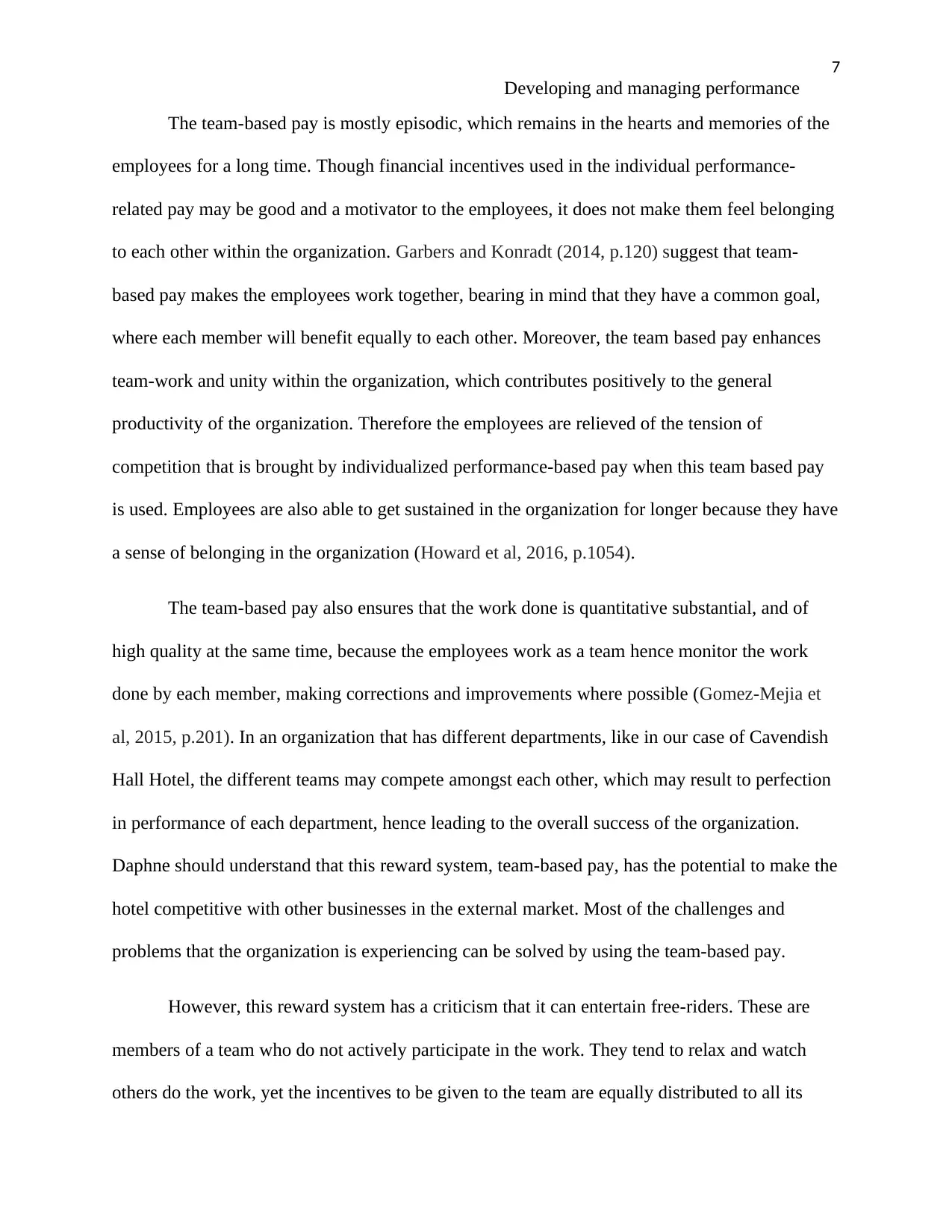
7
Developing and managing performance
The team-based pay is mostly episodic, which remains in the hearts and memories of the
employees for a long time. Though financial incentives used in the individual performance-
related pay may be good and a motivator to the employees, it does not make them feel belonging
to each other within the organization. Garbers and Konradt (2014, p.120) suggest that team-
based pay makes the employees work together, bearing in mind that they have a common goal,
where each member will benefit equally to each other. Moreover, the team based pay enhances
team-work and unity within the organization, which contributes positively to the general
productivity of the organization. Therefore the employees are relieved of the tension of
competition that is brought by individualized performance-based pay when this team based pay
is used. Employees are also able to get sustained in the organization for longer because they have
a sense of belonging in the organization (Howard et al, 2016, p.1054).
The team-based pay also ensures that the work done is quantitative substantial, and of
high quality at the same time, because the employees work as a team hence monitor the work
done by each member, making corrections and improvements where possible (Gomez-Mejia et
al, 2015, p.201). In an organization that has different departments, like in our case of Cavendish
Hall Hotel, the different teams may compete amongst each other, which may result to perfection
in performance of each department, hence leading to the overall success of the organization.
Daphne should understand that this reward system, team-based pay, has the potential to make the
hotel competitive with other businesses in the external market. Most of the challenges and
problems that the organization is experiencing can be solved by using the team-based pay.
However, this reward system has a criticism that it can entertain free-riders. These are
members of a team who do not actively participate in the work. They tend to relax and watch
others do the work, yet the incentives to be given to the team are equally distributed to all its
Developing and managing performance
The team-based pay is mostly episodic, which remains in the hearts and memories of the
employees for a long time. Though financial incentives used in the individual performance-
related pay may be good and a motivator to the employees, it does not make them feel belonging
to each other within the organization. Garbers and Konradt (2014, p.120) suggest that team-
based pay makes the employees work together, bearing in mind that they have a common goal,
where each member will benefit equally to each other. Moreover, the team based pay enhances
team-work and unity within the organization, which contributes positively to the general
productivity of the organization. Therefore the employees are relieved of the tension of
competition that is brought by individualized performance-based pay when this team based pay
is used. Employees are also able to get sustained in the organization for longer because they have
a sense of belonging in the organization (Howard et al, 2016, p.1054).
The team-based pay also ensures that the work done is quantitative substantial, and of
high quality at the same time, because the employees work as a team hence monitor the work
done by each member, making corrections and improvements where possible (Gomez-Mejia et
al, 2015, p.201). In an organization that has different departments, like in our case of Cavendish
Hall Hotel, the different teams may compete amongst each other, which may result to perfection
in performance of each department, hence leading to the overall success of the organization.
Daphne should understand that this reward system, team-based pay, has the potential to make the
hotel competitive with other businesses in the external market. Most of the challenges and
problems that the organization is experiencing can be solved by using the team-based pay.
However, this reward system has a criticism that it can entertain free-riders. These are
members of a team who do not actively participate in the work. They tend to relax and watch
others do the work, yet the incentives to be given to the team are equally distributed to all its
Paraphrase This Document
Need a fresh take? Get an instant paraphrase of this document with our AI Paraphraser
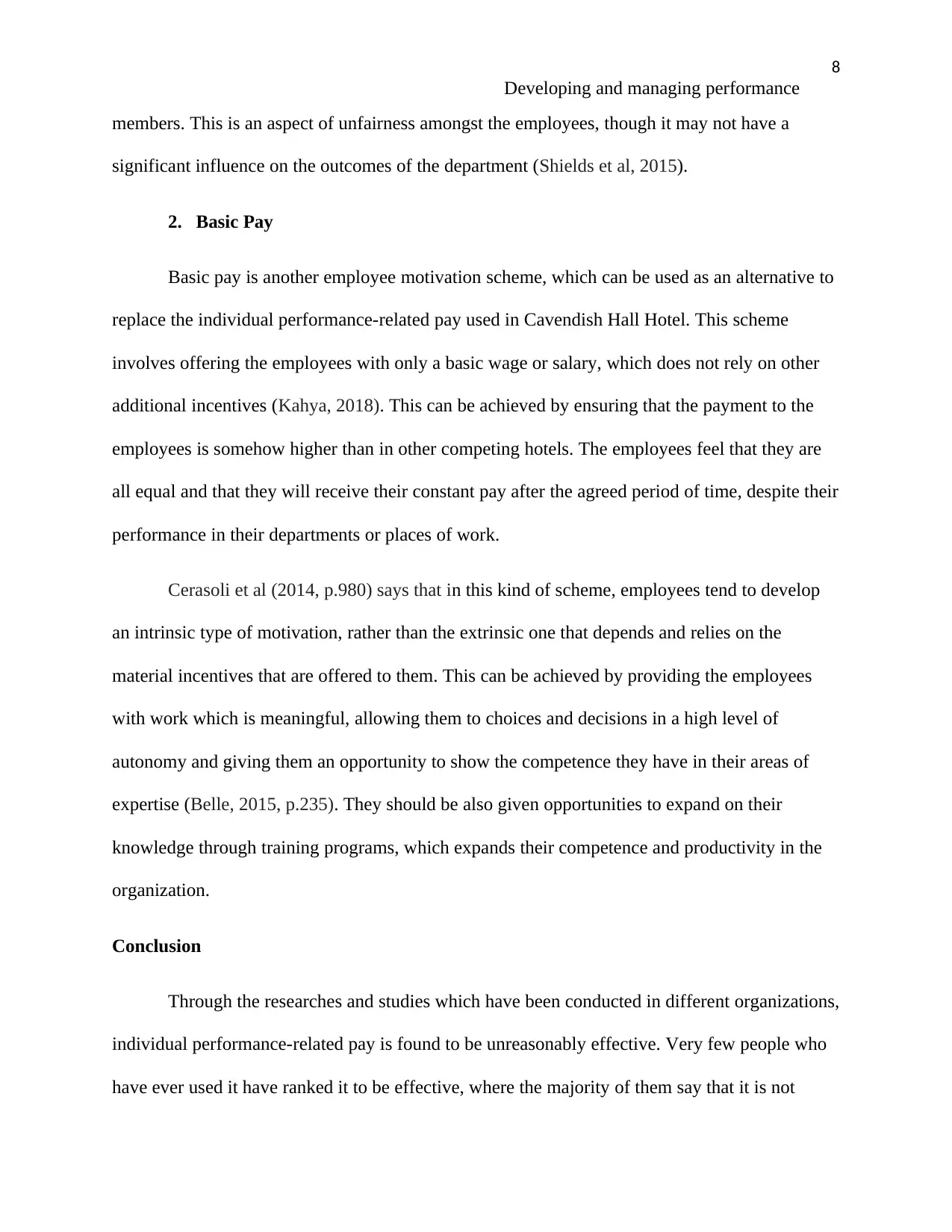
8
Developing and managing performance
members. This is an aspect of unfairness amongst the employees, though it may not have a
significant influence on the outcomes of the department (Shields et al, 2015).
2. Basic Pay
Basic pay is another employee motivation scheme, which can be used as an alternative to
replace the individual performance-related pay used in Cavendish Hall Hotel. This scheme
involves offering the employees with only a basic wage or salary, which does not rely on other
additional incentives (Kahya, 2018). This can be achieved by ensuring that the payment to the
employees is somehow higher than in other competing hotels. The employees feel that they are
all equal and that they will receive their constant pay after the agreed period of time, despite their
performance in their departments or places of work.
Cerasoli et al (2014, p.980) says that in this kind of scheme, employees tend to develop
an intrinsic type of motivation, rather than the extrinsic one that depends and relies on the
material incentives that are offered to them. This can be achieved by providing the employees
with work which is meaningful, allowing them to choices and decisions in a high level of
autonomy and giving them an opportunity to show the competence they have in their areas of
expertise (Belle, 2015, p.235). They should be also given opportunities to expand on their
knowledge through training programs, which expands their competence and productivity in the
organization.
Conclusion
Through the researches and studies which have been conducted in different organizations,
individual performance-related pay is found to be unreasonably effective. Very few people who
have ever used it have ranked it to be effective, where the majority of them say that it is not
Developing and managing performance
members. This is an aspect of unfairness amongst the employees, though it may not have a
significant influence on the outcomes of the department (Shields et al, 2015).
2. Basic Pay
Basic pay is another employee motivation scheme, which can be used as an alternative to
replace the individual performance-related pay used in Cavendish Hall Hotel. This scheme
involves offering the employees with only a basic wage or salary, which does not rely on other
additional incentives (Kahya, 2018). This can be achieved by ensuring that the payment to the
employees is somehow higher than in other competing hotels. The employees feel that they are
all equal and that they will receive their constant pay after the agreed period of time, despite their
performance in their departments or places of work.
Cerasoli et al (2014, p.980) says that in this kind of scheme, employees tend to develop
an intrinsic type of motivation, rather than the extrinsic one that depends and relies on the
material incentives that are offered to them. This can be achieved by providing the employees
with work which is meaningful, allowing them to choices and decisions in a high level of
autonomy and giving them an opportunity to show the competence they have in their areas of
expertise (Belle, 2015, p.235). They should be also given opportunities to expand on their
knowledge through training programs, which expands their competence and productivity in the
organization.
Conclusion
Through the researches and studies which have been conducted in different organizations,
individual performance-related pay is found to be unreasonably effective. Very few people who
have ever used it have ranked it to be effective, where the majority of them say that it is not
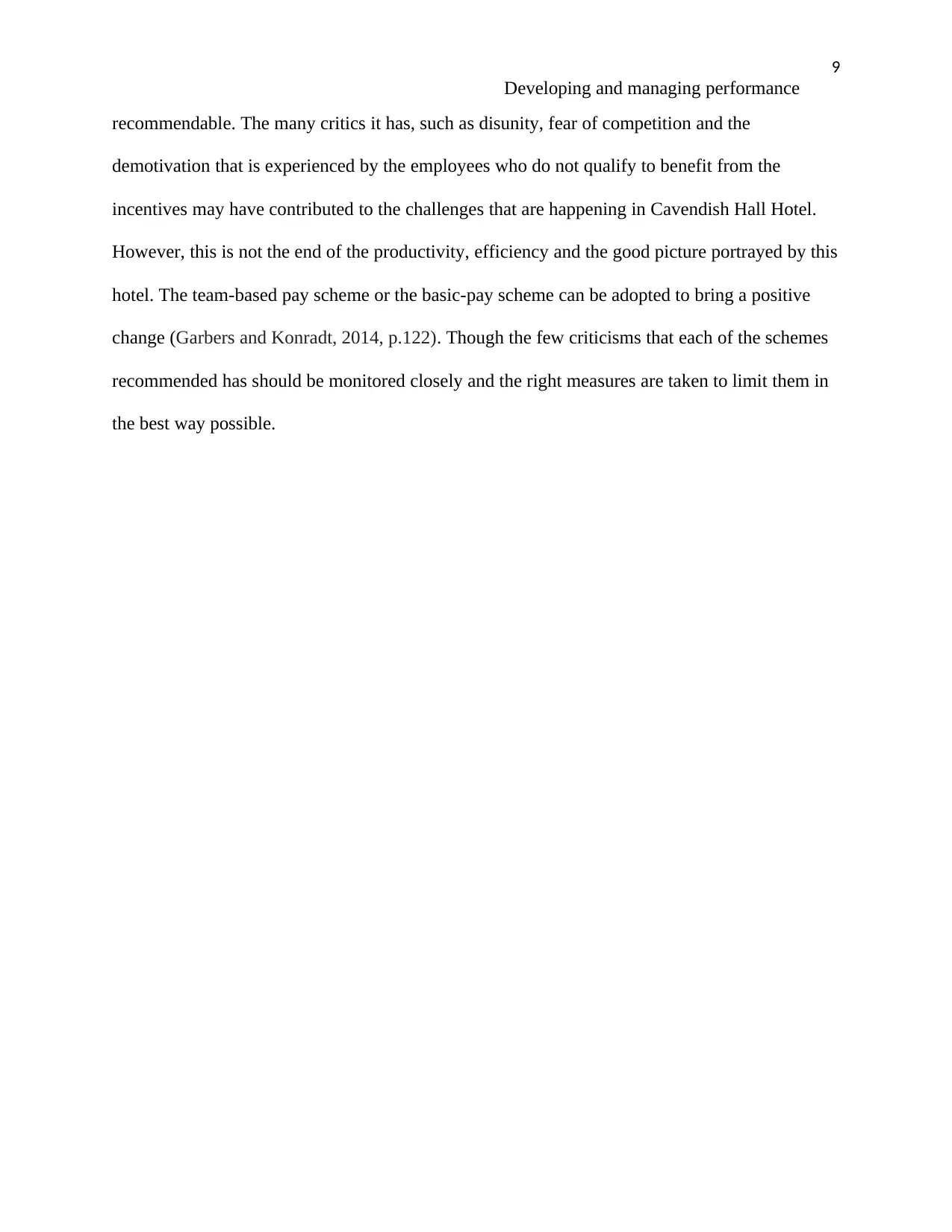
9
Developing and managing performance
recommendable. The many critics it has, such as disunity, fear of competition and the
demotivation that is experienced by the employees who do not qualify to benefit from the
incentives may have contributed to the challenges that are happening in Cavendish Hall Hotel.
However, this is not the end of the productivity, efficiency and the good picture portrayed by this
hotel. The team-based pay scheme or the basic-pay scheme can be adopted to bring a positive
change (Garbers and Konradt, 2014, p.122). Though the few criticisms that each of the schemes
recommended has should be monitored closely and the right measures are taken to limit them in
the best way possible.
Developing and managing performance
recommendable. The many critics it has, such as disunity, fear of competition and the
demotivation that is experienced by the employees who do not qualify to benefit from the
incentives may have contributed to the challenges that are happening in Cavendish Hall Hotel.
However, this is not the end of the productivity, efficiency and the good picture portrayed by this
hotel. The team-based pay scheme or the basic-pay scheme can be adopted to bring a positive
change (Garbers and Konradt, 2014, p.122). Though the few criticisms that each of the schemes
recommended has should be monitored closely and the right measures are taken to limit them in
the best way possible.
⊘ This is a preview!⊘
Do you want full access?
Subscribe today to unlock all pages.

Trusted by 1+ million students worldwide
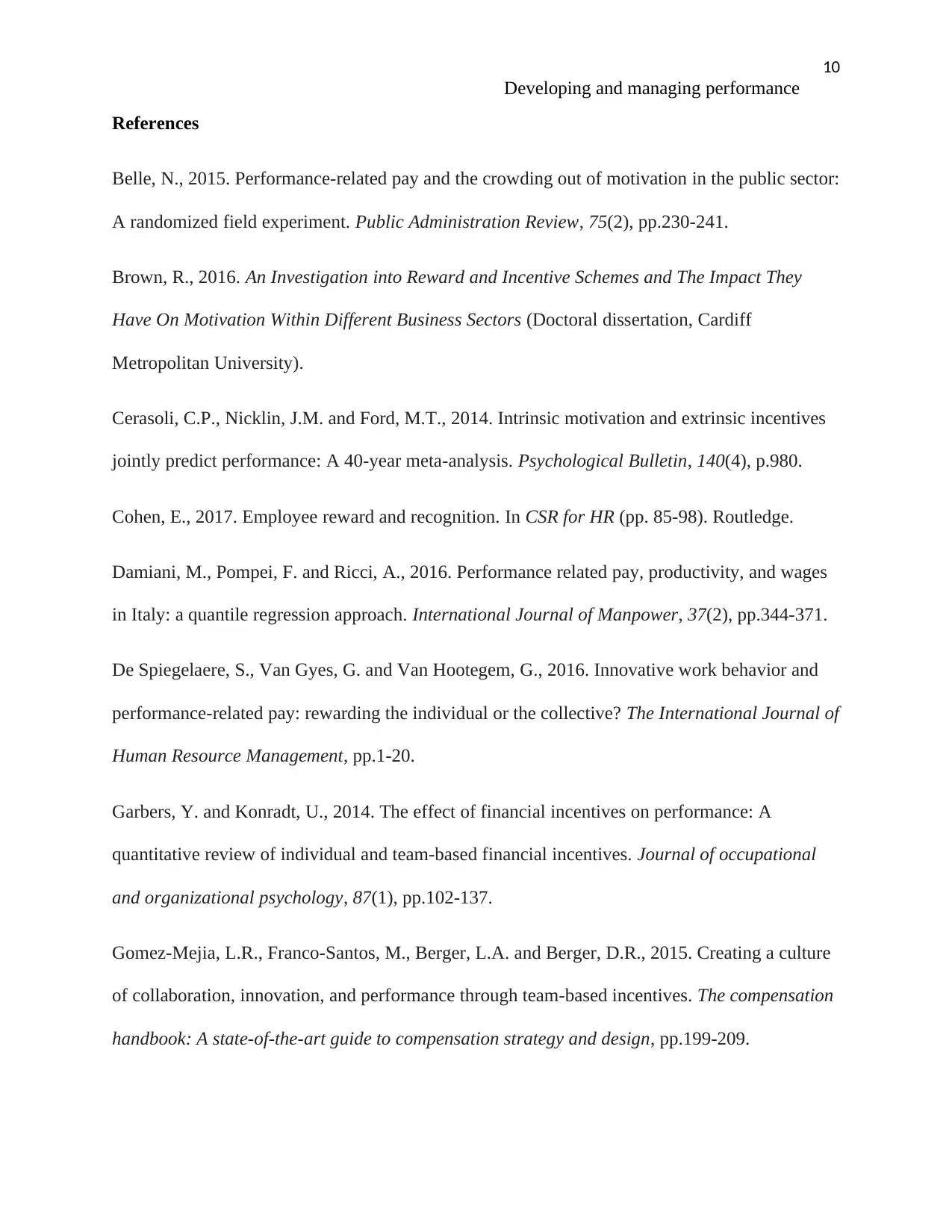
10
Developing and managing performance
References
Belle, N., 2015. Performance‐related pay and the crowding out of motivation in the public sector:
A randomized field experiment. Public Administration Review, 75(2), pp.230-241.
Brown, R., 2016. An Investigation into Reward and Incentive Schemes and The Impact They
Have On Motivation Within Different Business Sectors (Doctoral dissertation, Cardiff
Metropolitan University).
Cerasoli, C.P., Nicklin, J.M. and Ford, M.T., 2014. Intrinsic motivation and extrinsic incentives
jointly predict performance: A 40-year meta-analysis. Psychological Bulletin, 140(4), p.980.
Cohen, E., 2017. Employee reward and recognition. In CSR for HR (pp. 85-98). Routledge.
Damiani, M., Pompei, F. and Ricci, A., 2016. Performance related pay, productivity, and wages
in Italy: a quantile regression approach. International Journal of Manpower, 37(2), pp.344-371.
De Spiegelaere, S., Van Gyes, G. and Van Hootegem, G., 2016. Innovative work behavior and
performance-related pay: rewarding the individual or the collective? The International Journal of
Human Resource Management, pp.1-20.
Garbers, Y. and Konradt, U., 2014. The effect of financial incentives on performance: A
quantitative review of individual and team‐based financial incentives. Journal of occupational
and organizational psychology, 87(1), pp.102-137.
Gomez-Mejia, L.R., Franco-Santos, M., Berger, L.A. and Berger, D.R., 2015. Creating a culture
of collaboration, innovation, and performance through team-based incentives. The compensation
handbook: A state-of-the-art guide to compensation strategy and design, pp.199-209.
Developing and managing performance
References
Belle, N., 2015. Performance‐related pay and the crowding out of motivation in the public sector:
A randomized field experiment. Public Administration Review, 75(2), pp.230-241.
Brown, R., 2016. An Investigation into Reward and Incentive Schemes and The Impact They
Have On Motivation Within Different Business Sectors (Doctoral dissertation, Cardiff
Metropolitan University).
Cerasoli, C.P., Nicklin, J.M. and Ford, M.T., 2014. Intrinsic motivation and extrinsic incentives
jointly predict performance: A 40-year meta-analysis. Psychological Bulletin, 140(4), p.980.
Cohen, E., 2017. Employee reward and recognition. In CSR for HR (pp. 85-98). Routledge.
Damiani, M., Pompei, F. and Ricci, A., 2016. Performance related pay, productivity, and wages
in Italy: a quantile regression approach. International Journal of Manpower, 37(2), pp.344-371.
De Spiegelaere, S., Van Gyes, G. and Van Hootegem, G., 2016. Innovative work behavior and
performance-related pay: rewarding the individual or the collective? The International Journal of
Human Resource Management, pp.1-20.
Garbers, Y. and Konradt, U., 2014. The effect of financial incentives on performance: A
quantitative review of individual and team‐based financial incentives. Journal of occupational
and organizational psychology, 87(1), pp.102-137.
Gomez-Mejia, L.R., Franco-Santos, M., Berger, L.A. and Berger, D.R., 2015. Creating a culture
of collaboration, innovation, and performance through team-based incentives. The compensation
handbook: A state-of-the-art guide to compensation strategy and design, pp.199-209.
Paraphrase This Document
Need a fresh take? Get an instant paraphrase of this document with our AI Paraphraser
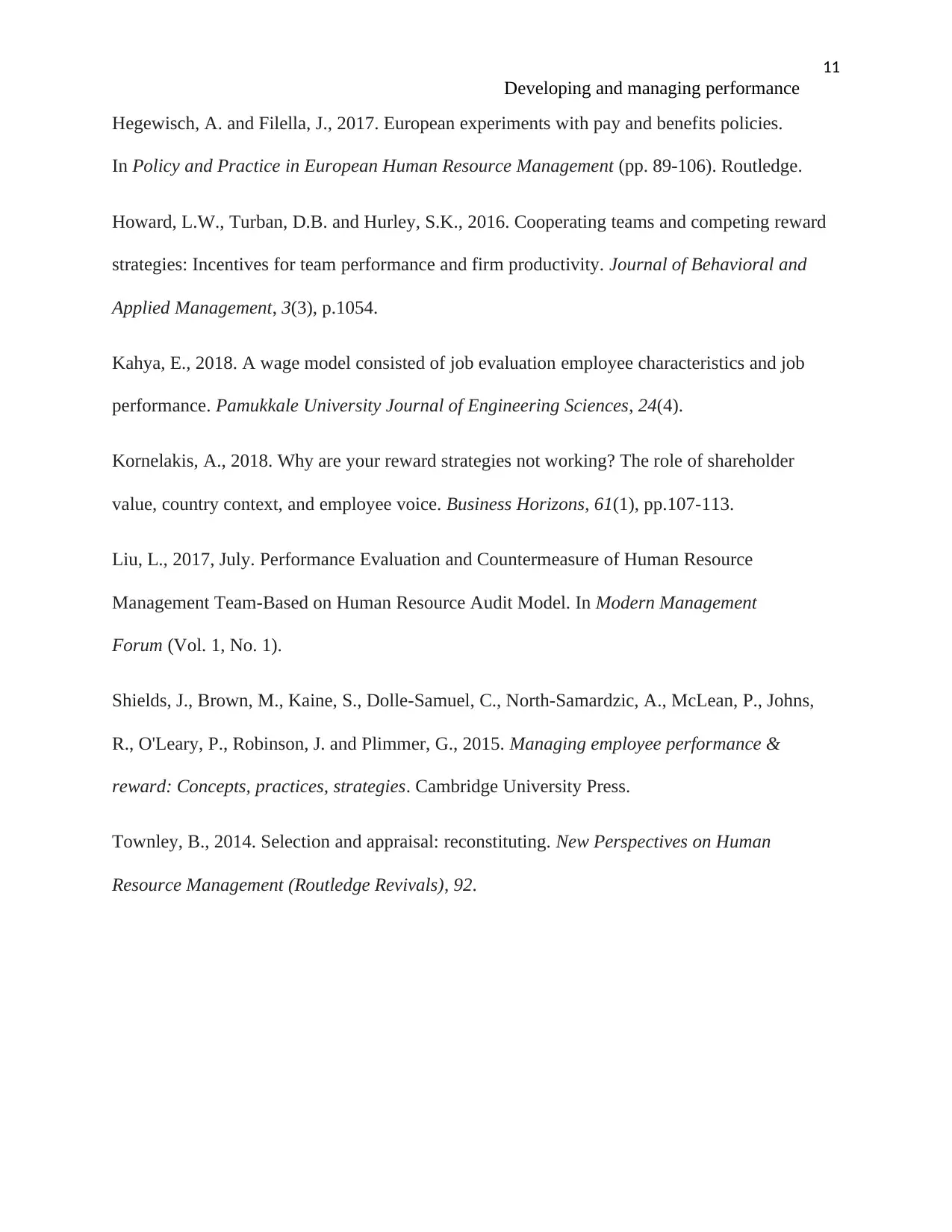
11
Developing and managing performance
Hegewisch, A. and Filella, J., 2017. European experiments with pay and benefits policies.
In Policy and Practice in European Human Resource Management (pp. 89-106). Routledge.
Howard, L.W., Turban, D.B. and Hurley, S.K., 2016. Cooperating teams and competing reward
strategies: Incentives for team performance and firm productivity. Journal of Behavioral and
Applied Management, 3(3), p.1054.
Kahya, E., 2018. A wage model consisted of job evaluation employee characteristics and job
performance. Pamukkale University Journal of Engineering Sciences, 24(4).
Kornelakis, A., 2018. Why are your reward strategies not working? The role of shareholder
value, country context, and employee voice. Business Horizons, 61(1), pp.107-113.
Liu, L., 2017, July. Performance Evaluation and Countermeasure of Human Resource
Management Team-Based on Human Resource Audit Model. In Modern Management
Forum (Vol. 1, No. 1).
Shields, J., Brown, M., Kaine, S., Dolle-Samuel, C., North-Samardzic, A., McLean, P., Johns,
R., O'Leary, P., Robinson, J. and Plimmer, G., 2015. Managing employee performance &
reward: Concepts, practices, strategies. Cambridge University Press.
Townley, B., 2014. Selection and appraisal: reconstituting. New Perspectives on Human
Resource Management (Routledge Revivals), 92.
Developing and managing performance
Hegewisch, A. and Filella, J., 2017. European experiments with pay and benefits policies.
In Policy and Practice in European Human Resource Management (pp. 89-106). Routledge.
Howard, L.W., Turban, D.B. and Hurley, S.K., 2016. Cooperating teams and competing reward
strategies: Incentives for team performance and firm productivity. Journal of Behavioral and
Applied Management, 3(3), p.1054.
Kahya, E., 2018. A wage model consisted of job evaluation employee characteristics and job
performance. Pamukkale University Journal of Engineering Sciences, 24(4).
Kornelakis, A., 2018. Why are your reward strategies not working? The role of shareholder
value, country context, and employee voice. Business Horizons, 61(1), pp.107-113.
Liu, L., 2017, July. Performance Evaluation and Countermeasure of Human Resource
Management Team-Based on Human Resource Audit Model. In Modern Management
Forum (Vol. 1, No. 1).
Shields, J., Brown, M., Kaine, S., Dolle-Samuel, C., North-Samardzic, A., McLean, P., Johns,
R., O'Leary, P., Robinson, J. and Plimmer, G., 2015. Managing employee performance &
reward: Concepts, practices, strategies. Cambridge University Press.
Townley, B., 2014. Selection and appraisal: reconstituting. New Perspectives on Human
Resource Management (Routledge Revivals), 92.
1 out of 11
Related Documents
Your All-in-One AI-Powered Toolkit for Academic Success.
+13062052269
info@desklib.com
Available 24*7 on WhatsApp / Email
![[object Object]](/_next/static/media/star-bottom.7253800d.svg)
Unlock your academic potential
Copyright © 2020–2025 A2Z Services. All Rights Reserved. Developed and managed by ZUCOL.





